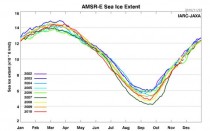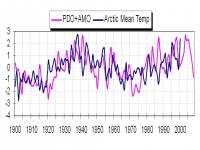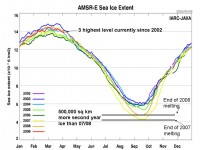By Edwin Mora, CNSNews
A scientist who tracks levels of ice and snow in the Arctic Ocean told CNSNews.com Monday that there is a “correlation” between the receding ice in the Arctic Sea and man-made global warming caused by the greenhouse effect. But Dr. Walter Meier, a cryosphere scientist at the National Snow and Ice Data Center (NSIDC) in Boulder, Colo., admits he can’t prove that the link is cause-and-effect.
“The thing that’s very clear is that the sea ice changes that we are seeing go hand in hand with the warming temperature that we’ve seen, particularly in the Arctic and around the globe,” Meier told CNSNews.com. Meier and a group of scientists from NASA - the National Aeronautics and Space Administration—announced Monday that this winter had the fifth lowest maximum ice extent on record. “The maximum sea ice extent for 2008-09, reached on Feb. 28, was 5.85 million square miles,” according to researchers at the NSDIC. “That is 278,000 square miles less than the average extent for 1979 to 2000.”
According to NASA, the NSDIC team used two years worth of data from NASA’s Ice, Cloud, and land Elevation Satellite (ICESat) to make his observations.
They found that seasonal ice averages about 6 feet in thickness, while ice that had lasted through more than one summer averages about 9 feet, though it can “grow much thicker in some locations near the coast.”
CNSNews.com posed a question to Meier: “Given the fact that Arctic sea ice has changed many times in the past, how is it possible to know scientifically whether the melting is due to so-called man-made ‘global warming’ or to a natural cyclical phenomenon?” Meier said he thinks there is a link between higher temperatures and increased greenhouse gases. But he admitted that sea ice has changed a lot through time and his understanding of long-term ice change is limited “somewhat” to century-old data.
“How it (Arctic sea ice) varied before our satellite record, which started in 1979, which is relatively short, is harder to say,” Meier told CNSNews.com, “although we have fairly good records at least back to the 1950s and somewhat that’s good through the early 1900s.”
But a veteran climatologist who questions the global warming idea, told CNSNes.com that NSIDC’s own data refute Meier’s claim - and point to “solar activity” as a prime cause for the melting ice pack. Dr. Joe D’Aleo, executive director of the International Climate and Environmental Change Assessment Project [ICECAP], said the depletion of sea ice in the Arctic is part of the Earth’s cycles - and “solar activity”
“The Arctic temperatures undergo a cyclical change every 60 to 70 years tied to cycles on the sun and in the oceans,” said D’Aleo, who was the first director of meteorology at The Weather Channel. “You can see very warm temperatures in the 1930s then cooling and another warming in the last few decades in close correlation with solar activity,” he added, “but with a poor correlation with CO2.”
D’Aleo said that NSIDC’s own research put a spotlight on the correlation between melting Arctic ice sheets and solar activity back in 2007. “One prominent researcher, Igor Polyakov at the University of Fairbanks, Alaska, pointed out that ‘pulses of unusually warm water have been entering the Arctic Ocean from the Atlantic, which several years later are seen in the ocean north of Siberia,’” D’Aleo said. “These pulses of water are helping to heat the upper Arctic Ocean, contributing to summer ice melt and helping to reduce winter ice growth.”
Evolution of the Arctic Regardless of its origin, the NASA and NSDIC scientists pointed out that melting sea ice is having profound effects on the Arctic.
According to Ronald Kwok, a research scientist at NASA’s Jet Propulsion Laboratory, older, thicker ice is disappearing and is being substituted by newer, thinner ice that is susceptible to the summer melt. “Thin seasonal ice - ice that melts and re-freezes every year - makes up about 70 percent of the Arctic sea in wintertime, up from 40 to 50 percent in the 1980s and 1990s,” according to the NASA scientist. Read full story here.
Note also in 2007, before alarmists took over, NSIDC also noted “Another scientist, Koji Shimada of the Japan Agency for Marine–Earth Science and Technology, reports evidence of changes in ocean circulation in the Pacific side of the Arctic Ocean. Through a complex interaction with declining sea ice, warm water entering the Arctic Ocean through Bering Strait in summer is being shunted from the Alaskan coast into the Arctic Ocean, where it fosters further ice loss” and importantly concluded (and I fully agree), “Many questions still remain to be answered, but these changes in ocean circulation may be important keys for understanding the observed loss of Arctic sea ice.” Also Rutger’s Jennifer Frances (2006) found the same thing - when water warms near the Barents Sea in the North Atlantic, several years later it travels beneath the ice and reaches the water near Siberia where it thins or melts it. Atlantic warmth peaked in 2004, 3 years before greatest arctic summer melt in 2007.
Willie Soon in 2004 showed how well arctic basin temperatures (Polyakov) correlated with total solar irradiance (Hoyt/Schatten) and how poorly it correlated with CO2.

See larger image here
I have found the Atlantic and Pacific temperature cycles also matched very well with the arctic temperatures as shown here.

See larger image here

See larger image here
See Steve Goddard’s excellent post on Watts Up With That here.
By Marc Sheppard in the American Thinker
When you hear the names Al Gore and James Hansen in the same sentence you immediately assume the subject to be manmade global warming panic. But there’s another distinction which links these two - they both steadfastly refuse to defend their positions in formal debate. And a recent performance by one of their own in just such a venue reminds us why.
Roll Call TV has just posted video of the March 27th debate they hosted between Marc Morano, former communications director for Sen. James Inhofe (R-OK), and Climate Progress’s Joe Romm. Part one begins here at about the 3:45 mark and Part two begins here directly. The two philosophical adversaries arguing the heated subject of “Green Politics” makes for a fabulous show—a must-see for all, particularly those still unsure why it is that the overwhelming majority of climate alarmists always find some excuse not to directly confront opposing opinion. And Romm wasted no time leaving no doubt, issuing these clumsily over the top words almost out of the gate: “On our current emissions path we are going to warm the United States 10-15 degrees Fahrenheit by the end of the century and sea level rise will be 5 feet or higher and a third of the planet will be desert.”
And just moments after grossly exaggerating the already hyped predictions of his fellow climate hysterics, he actually summoned the insolence to say that “the thing you have to understand about Marc Morano is that he basically makes stuff up and misrepresents science.” An accusation he’d later repeat and broaden to include Morano’s ex-boss and, ultimately, anyone else not buying the hype Romm and his accomplices have been selling door-to-door these many years.
Granted, self-reflection has never been an inherent trait amongst climate alarmists, but consider Romm’s own blatant fabrications and misrepresentations in the three predictions of his opening salvo. Even the overly venerated Intergovernmental Panel on Climate Change (IPCC) 2007 Fourth Assessment Report (AR4) predicted that climate sensitivity (change in mean global temperatures resulting from a sustained doubling of atmospheric CO2 concentration) would likely range between 2 and 4.5C, and would most probably border on 3C.
And from what sci-fi flick did Romm draw his assertion of a 5 foot or higher sea level rise? Referring again to AR4, even the IPCC’s intentionally alarm-biased models only projected figures running from 0.18 to 0.59 meters by 2100. But people like Marc Morano misrepresent science in order to spread their bogus gospel.
Now we come to the final eight words of Romm’s fantastic sentence. A third of the planet will be desert. This one is either intentionally vague, just plain dumb, or both. For starters, only one-third of the planet is landmass, and that’s before much of it is drenched by Romm’s fantasy waves of runaway sea elevation. Is he suggesting that in a mere 90 years the entire landmass of the planet will be an arid, hostile, lizard infested wasteland?
On the other hand, perhaps I’m being unfair and misunderstanding his meaning. Perhaps he actually meant that one-third of dry land will be reduced to desert by 2100. Of course, that would still be horrible news because ……. Wait a minute, according to the US Geological Survey, approximately one-third of the Earth’s land surface already is desert. So Romm is either predicting no change whatsoever or a complete Terradeformation in a time-span even Star-Trek engineers would be proud of. Unless, of course, he hasn’t given it much thought at all but hopes the media and most citizens will continue to ignore what truth hides beneath the shocking imagery. Read much more here and be sure to listen to the debate and spread the links amongst your friends.
Read another take on this debate (smackdown 2) here. And see this blog: ‘Romm is spouting hysterical nonsense...So this is the best they can do? This is the “physicist and climate expert here?’


